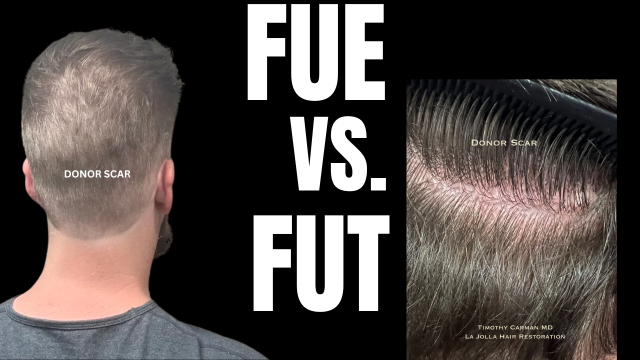When it comes to modern hair restoration, FUE (Follicular Unit Extraction) has become the buzzword. Scroll through social media and you’ll see influencers and clinics praising its minimally invasive approach. But what about FUT (Follicular Unit Transplantation) — the so-called “strip method” that many now consider outdated?
The truth is, FUT isn’t dead. In fact, it still plays a critical role in modern surgical planning, particularly for patients seeking maximum graft yield, women who prefer not to shave, or anyone considering a combined approach.
Let’s take a deeper look at FUE vs FUT — their pros, cons, and how today’s best surgeons are blending the two techniques to create natural, lasting transformations.
What Is FUE?
FUE (Follicular Unit Extraction) involves removing individual follicular units directly from the donor area, typically using a tiny punch device less than 1mm in diameter.
Advantages of FUE include:
- No visible linear scar — ideal for short hairstyles
- Faster healing time and less postoperative discomfort
- Ability to extract from multiple donor areas (beard, chest, etc.)
- Excellent option for smaller sessions or touch-ups
However, FUE is not always the best for every patient. When surgeons over-harvest the donor area, it can cause visible thinning. Additionally, large FUE sessions can require the head to be shaved, which many female and professional patients prefer to avoid.
Learn more about how patients document their FUE hair transplant journeys here.
What Is FUT?
FUT (Follicular Unit Transplantation), often called the “strip method,” involves removing a thin strip of scalp from the donor area — usually the back of the head — then dissecting it under a microscope to isolate follicular units.
Key benefits of FUT include:
- Higher graft yield per session
- Ideal for those who need significant coverage (advanced hair loss)
- The donor area remains hidden beneath existing hair
- No full head shaving required — a major advantage for female patients
- Minimizes donor depletion for future FUE sessions
While FUT leaves a linear scar, skilled surgeons today use trichophytic closure techniques that make scars nearly invisible, even with relatively short hair.
See hundreds of real FUT results shared by patients on the Hair Restoration Network forum.
Is FUT Really Outdated?
Not at all. While the industry has leaned toward FUE marketing, many of the world’s most respected surgeons still perform FUT in 2025 — especially for:
- High-density restorations (3,000–5,000+ grafts)
- Female hair transplants, where shaving isn’t ideal
- Combination cases, where FUT and FUE together create the best possible donor management
In fact, a hybrid approach — starting with FUT and following with FUE — can maximize donor supply while maintaining natural density and minimal visible scarring.
Combining FUE and FUT: The Best of Both Worlds
Many elite surgeons listed in the Hair Transplant Network Directory use a combined FUE + FUT strategy for advanced hair loss cases.
Why combine them?
- FUT allows surgeons to extract a large number of grafts efficiently
- FUE can then refine density, fill gaps, or enhance hairline design
- The combination maintains donor area integrity and natural appearance
This approach is particularly useful for patients with Norwood 5–7 hair loss, where achieving full coverage with FUE alone may over-stress the donor zone.
FUE vs FUT for Women
For women, FUT often remains the preferred choice. Since FUT doesn’t require shaving the donor area, female patients can undergo surgery discreetly. The scar is hidden beneath existing hair, and recovery is typically smooth.
FUE can still be performed on women, but it often requires trimming a donor section — something not every patient is comfortable with. This is why experienced surgeons tailor the plan to each patient’s goals, hairstyle, and donor characteristics.
Explore real female hair transplant stories here to see which method worked best for others.
Scarring, Healing, and Recovery
FUE scars: Tiny dot scars that blend easily, even with short haircuts
FUT scars: A fine linear scar hidden under surrounding hair
With modern closure techniques and expert hands, both methods deliver excellent cosmetic outcomes. The key difference lies not in the technique itself, but in the surgeon’s experience and donor management strategy.
Which Method Is Right for You?
The answer depends on:
- Your hair loss pattern and donor density
- Your hairstyle preferences
- Your future surgical plans
- Your tolerance for downtime and scarring
In 2025, many top surgeons no longer view FUE and FUT as competitors, but rather as complementary tools that together provide the most natural, sustainable, and customized results.
Where to See Real Results and Reviews
Before choosing a clinic, see what real patients are saying.
Visit the Hair Restoration Network Forum — a free, transparent community where members post their own before-and-after photos, surgical experiences, and follow-ups from FUE and FUT procedures worldwide.
This open platform helps you:
- Compare surgeon results side-by-side
- Learn from real patients’ timelines and healing progress
- Avoid marketing hype and get unbiased insights
Consult a Trusted Hair Transplant Surgeon
Once you’re ready to explore your options, consult a verified, recommended surgeon through the
Hair Transplant Network Directory
All physicians listed are thoroughly vetted for:
- Proven patient results
- Consistent ethical practices
- Surgical experience in both FUE and FUT techniques
Conclusion: FUT Isn’t Gone — It’s Just Evolved
While FUE continues to dominate headlines, FUT remains a vital tool in the modern hair restoration arsenal. The best surgeons understand when—and how—to use each technique, sometimes combining them for optimal results.
Whether you’re leaning toward FUE, FUT, or a hybrid approach, the most important step is choosing a surgeon who tailors the plan to your specific needs.
Explore real patient stories on the Hair Restoration Network Forum and connect with a trusted, world-class doctor from the Hair Transplant Network Directory today.

